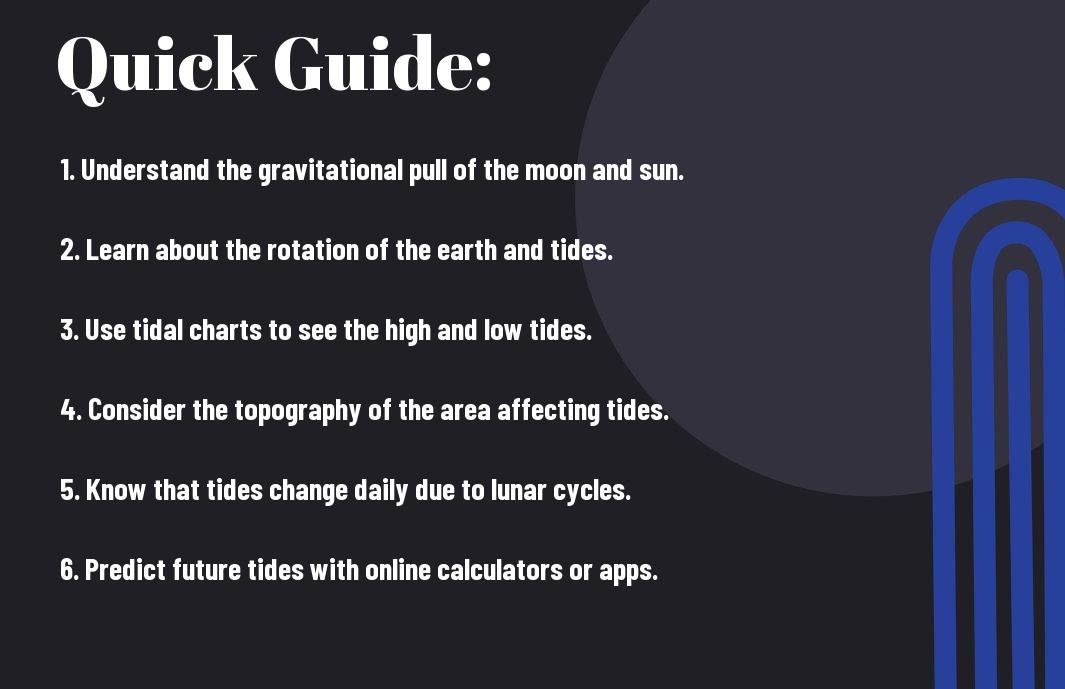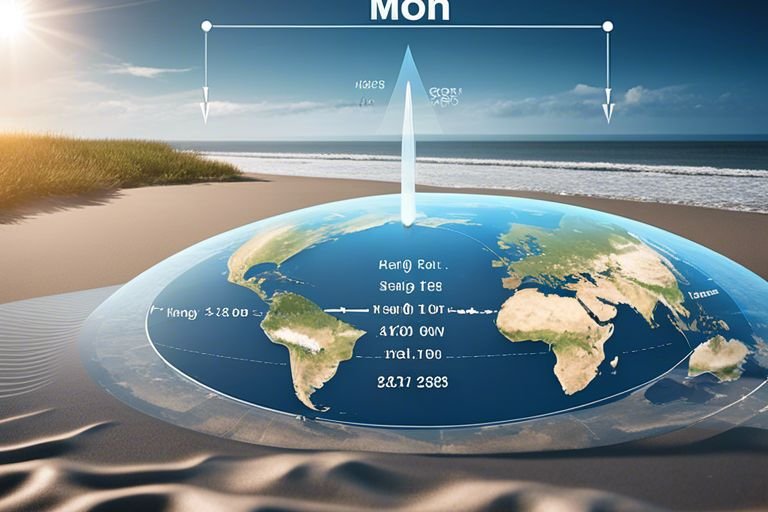Rarely do we stop to think about the ebb and flow of the tides, yet they are a vital part of our coastal ecosystems and our daily lives. Understanding the tidal cycle can be crucial for activities such as boating, fishing, or even just taking a stroll along the beach. In this guide, I will explain the factors that cause the tides to come in and go out, as well as how to predict their movements. By the end of this post, you will have a clear understanding of how the gravitational pull of the moon and sun impacts the tides, and how tidal predictions can help you plan your coastal activities with confidence. Whether you’re a seasoned sailor or a casual beach-goer, knowing when the tide will come in and go out can greatly enhance your experience by keeping you safe and informed.
Key Takeaways:
- Tidal cycle is caused by the gravitational pull of the moon and the sun on the Earth’s water, creating a regular pattern of high and low tides.
- Prediction of the tidal cycle is based on the position of the moon and the sun, as well as the geography of the coastline, and can be accurately forecasted using tidal charts and tables.
- High tides occur when the water level reaches its peak, while low tides occur when the water level is at its lowest, and these events happen approximately twice a day.
- Understanding when the tide comes in and goes out is crucial for activities such as boating, fishing, and beachcombing, as it affects access to coastal areas and marine life behavior.
- By recognizing the patterns and causes of the tidal cycle, individuals can better plan and enjoy their coastal experiences while also appreciating the natural forces that drive these phenomena.
Types of Tides
For those who are curious about the different types of tides that occur, it’s important to understand that there are two main types: spring tides and neap tides. These tides are caused by the gravitational pull of the moon and the sun on the Earth’s oceans.
| Spring Tides | Neap Tides |
| Occur during a full or new moon | Occur during the first and last quarter moons |
| Result in higher high tides and lower low tides | Result in moderate high tides and low tides |
| Caused by the combined gravitational pull of the sun and moon | Caused by the sun and moon pulling at right angles to each other |
| Can lead to more extreme tidal ranges | Result in less extreme tidal ranges |
| Can impact coastal flooding and erosion | Can impact marine life and navigation |
High Tides
One of the most dramatic moments in the tidal cycle is the high tide. During a high tide, the water level rises to its highest point before gradually receding. High tides occur twice each day when the gravitational pull of the moon and sun align, causing a bulge in the ocean’s surface. This phenomenon can lead to coastal flooding and erosion, but also creates opportunities for activities like surfing and fishing.
Low Tides
Conversely, low tides occur when the water level reaches its lowest point before beginning to rise again. These periods of low water are influenced by the gravitational pull of the moon and sun, and can reveal fascinating marine life in tidal pools and create ideal conditions for activities like tide pool exploration and beachcombing. However, it’s important to note that low tides can also present hazards for boating and navigation, as certain areas may become unexpectedly shallow.
Factors Affecting the Tidal Cycle
Now, let’s delve into the various factors that affect the tidal cycle. Understanding these factors is crucial in predicting the tides and their behavior. Here are some of the key factors to consider:
- Gravitational Pull
- Moon Phases
- Earth’s Rotation
Recognizing the importance of these factors will help you gain a comprehensive understanding of the tidal cycle and make more accurate predictions.
Gravitational Pull
The gravitational pull of the Moon and the Sun plays a major role in creating tides. The gravitational force exerted by these celestial bodies causes the oceans to bulge, creating high tides in the areas facing the Moon and on the opposite side of the Earth. This phenomenon occurs due to the difference in gravitational force across the Earth’s surface, resulting in the tidal cycle.
Moon Phases
The phases of the Moon also have a significant impact on the tides. During a full moon and a new moon, when the Moon, Earth, and the Sun are aligned, the gravitational pull is intensified, leading to higher high tides and lower low tides, known as spring tides. Conversely, during the first and third quarter phases, when the gravitational forces are perpendicular, the high tides are lower and the low tides are higher, known as neap tides.
Earth’s Rotation
The rotation of the Earth also influences the tides. As the Earth rotates on its axis, the oceans experience a bulging effect due to the centrifugal force, creating two tidal bulges on opposite sides of the planet. This results in the occurrence of two high tides and two low tides in a 24-hour period.
Tips for Predicting Tides
Your ability to predict tides accurately can greatly enhance your experience with the tidal cycle. Here are some helpful tips for predicting tides:
- Observe the moon phases and understand their impact on tides
- Consult tide charts for your specific location
- Use tidal prediction apps for real-time information
Recognizing these key factors will empower you to make informed decisions and maximize your enjoyment of coastal activities.
Observation of Moon Phases
Understanding the relationship between the moon phases and the tides can provide valuable insight into predicting when the tide will come in and go out. As the moon orbits the Earth, its gravitational pull causes the water levels to rise and fall. During a full or new moon, when the sun, moon, and Earth are aligned, we experience higher high tides and lower low tides, known as spring tides. Conversely, during the first and third quarters of the moon, when the sun and moon are at right angles to each other, we experience lower high tides and higher low tides, known as neap tides. By paying attention to the moon phases, you can anticipate the behavior of the tides with greater accuracy.
Consulting Tide Charts
When it comes to predicting tides, nothing beats the reliability of tide charts. These charts provide detailed information about the times and heights of high and low tides for specific locations. By consulting a tide chart for your area, you can plan your coastal activities with confidence, knowing exactly when the tide will be at its highest or lowest point. Whether you’re a beachcomber, surfer, or fisherman, having access to accurate tide charts is essential for maximizing your enjoyment of coastal environments.
Using Tidal Prediction Apps
With the advent of technology, predicting tides has become easier than ever with the use of tidal prediction apps. These apps provide real-time information about tides, allowing you to access tide predictions right from your smartphone. Whether you’re planning a day of boating, kayaking, or simply enjoying a day at the beach, tidal prediction apps can provide valuable insights to ensure a safe and enjoyable experience. Many of these apps also offer additional features such as sunrise and sunset times, marine weather forecasts, and currents, making them an indispensable tool for anyone who spends time near the coast.
Pros and Cons of Tidal Predictions
To accurately predict the tides can be beneficial for various activities such as fishing, boating, and coastal development. On the other hand, it also presents some challenges and limitations, especially when it comes to precision and accuracy. Let’s take a closer look at the pros and cons of tidal predictions.
| Pros | Cons |
| Predictable timing for coastal activities | Limitations in precision and accuracy |
| Assistance in maritime navigation | Challenges in predicting extreme tides |
| Useful for coastal resource management | Vulnerability to weather and climate changes |
| Potential for harnessing tidal energy | Impacts on wildlife and ecosystems |
| Opportunities for recreational activities | Costs and resources required for monitoring and predictions |
Benefits of Accurate Predictions
Accurate tidal predictions provide crucial information for various coastal activities, such as fishing, boating, and beachcombing. Knowing the precise timing of high and low tides can enhance safety and efficiency in maritime navigation. Additionally, coastal managers and developers rely on accurate tidal predictions to plan and execute construction projects, ensuring minimal impact on the environment and the local community. Having access to reliable tidal predictions also opens opportunities for harnessing tidal energy, a clean and renewable source of power.
Limitations and Challenges
Despite the benefits, predicting tides comes with its limitations and challenges. One major challenge is the precision and accuracy of predictions, as they can be influenced by various factors such as weather patterns and climate changes. Additionally, extreme tides, such as storm surges and king tides, pose challenges for accurate predictions, impacting coastal communities and ecosystems. Moreover, the monitoring and prediction of tides require significant resources, both in terms of costs and technological infrastructure, which can be a limitation for some regions and communities.

Conclusion
Summing up, understanding the tidal cycle is crucial for various reasons including navigation, fishing, and coastal management. By knowing when the tide comes in and goes out, you can plan your activities accordingly and minimize any potential risks. Additionally, knowing the causes of tides and the factors that influence them can help predict the tidal cycle with greater precision. By paying attention to the gravitational pull of the moon and the sun, as well as the topography of the coastline, you can better anticipate the ebb and flow of the tides. With this knowledge, you can make the most of your time by the shore and ensure your safety while enjoying the coastline.
FAQ – When Does the Tide Come in and Go Out – The Explanation and Prediction of the Tidal Cycle
Q: What causes the tides to come in and go out?
A: The tides are primarily caused by the gravitational pull of the moon and the sun on the Earth’s oceans. The position of the moon and the sun in relation to the Earth, as well as the Earth’s rotation, create the tidal cycle.
Q: How often do tides occur?
A: Tides occur approximately every 12 hours and 25 minutes. This means there are typically two high tides and two low tides each day.
Q: What factors can affect the timing and height of tides?
A: The timing and height of tides can be affected by factors such as the shape of the coastline, the depth of the water, the wind, and atmospheric pressure. These factors can cause variations in the expected tidal patterns.
Q: Can tides be predicted in advance?
A: Yes, tides can be predicted with a high degree of accuracy. Scientists and experts use tidal charts and data on the positions of the moon and the sun to forecast the timing and height of tides for specific locations and dates.
Q: How can I find out the timing of high and low tides for a specific location?
A: There are numerous sources where you can find tidal predictions for specific locations, including websites, smartphone apps, and printed tide tables. Local marine and weather offices also provide information on tides for specific areas.

